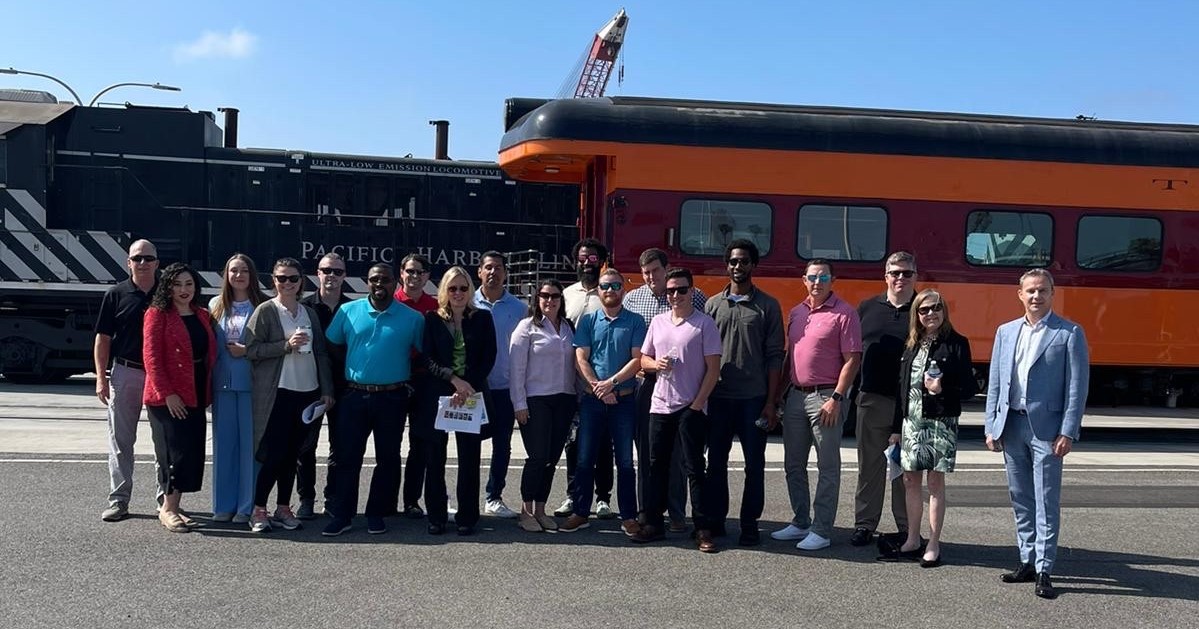When it was time for Master’s Degree students in the University of Denver’s (DU) Transportation and Supply Chain Institute to experience the transportation industry at one of its critical nerve centers, they visited Pacific Harbor Line (PHL), the short-line railroad responsible for maintaining fluidity inside America’s busiest intermodal gateway.
For an entire week in July, Institute students toured various infrastructure facilities associated with the Port of Long Beach and other program partners such as UPS, Matson, and PHL.
Owned by Chicago-based Anacostia Rail Holdings, PHL provides rail transportation and dispatching for the Ports of Long Beach and Los Angeles, which together form America’s largest container port. In addition to annually switching approximately 40,000 freight cars annually, PHL switches nine on-dock intermodal terminals and dispatches more than 30 stack trains on a 24/7 basis to its Class I partners BNSF Railway and Union Pacific.
The Port and PHL welcomed 15 DU students to the tour, led by Institute Executive Director David Fisher. The students are part of a six-quarter Master of Science Degree program, and each quarter includes a residency week such as the visit to Long Beach.
“These field trips help coalesce and solidify the theory and logic that we are delivering in the classroom,” says Fisher. “For our executive students, it is a terrific way to observe the complications between different logistics operations.”
Presenters from PHL included Otis Cliatt II, PHL president; Stephane Perri, vice president; Diana Turubanova, manager of sales and customer service; and Rick VanZee, superintendent. Presenters from the Port of Long Beach included Noel Hacegaba, deputy executive director of administration and operations; Matthew Arms, director of environmental planning; Eleanor Torres, director of government relations; and, Randall Smith, manager of business development.
Among the high points of the visit was the passenger train tour of PHL’s manifest and intermodal operations, the Alameda Corridor—the key rail artery linking the ports with the U.S. railway system—as well as the Badger Bridge to the Terminal Island complex. Separately, the students also received a waterborne tour of the Port of Long Beach, which collectively provided a full scope of how traffic moves through the system.
The DU students couldn’t find a better example of a railroad operating in the heart of today’s complex transportation network. Although technically a short line, Pacific Harbor Line has all the attributes of its Class I partners, including a double-track main line, centralized traffic control, and a full slate of approximately 30 daily crews serving the port’s marine terminals, plus as many as 10 daily switch jobs serving PHL’s carload customers.
As writer Bill Stephens describes it in a September 2022 Trains magazine cover story, “Pacific Harbor Line stands in a league of its own. The railroad that serves the ports of Los Angeles and Long Beach is a short line in the sense that its trains roll over 19 route-miles and grand total of 96 miles of track. But nearly all the railroad’s short-line similarities end there.”
In PHL, Institute Director Fisher sees a highly complex and proficient railroad that ties in directly with the goals of the program.
“Seeing the primary rail connector of the largest port pair in the United States is a quite powerful experience for professional logisticians,” Fisher explains. “Learning the details of the PHL operation demonstrates solution management of composite activities. We were thrilled to get such a comprehensive tour and will no doubt be back with a future cohort of our program.”
This year’s DU visitors included Kimia Khatami, Anacostia Rail Holdings senior director of business development, herself a student at the Institute. She says the Institute has attracted transportation and supply-chain professionals from across a wide array of sectors due to its combined academic and hands-on approach to teaching.
“This residency week in Southern California was truly a highlight of the program,” says Khatami. “The advantage of being in a cohort of students, who are already successful professionals in diverse roles within their companies, is that we learn as much from each other as we do our professors and faculty. The recruiting process has been refined over the many years that this program has been founded and it targets those who are strong contributors to the field with bright futures ahead.”
Khatami also views the DU partnership as a natural fit for ARH. She says, “It fosters collaboration between companies represented by either their students or board members, and allows for an abundant exchange of ideas and business opportunities, while building long-lasting industry relationships.”

